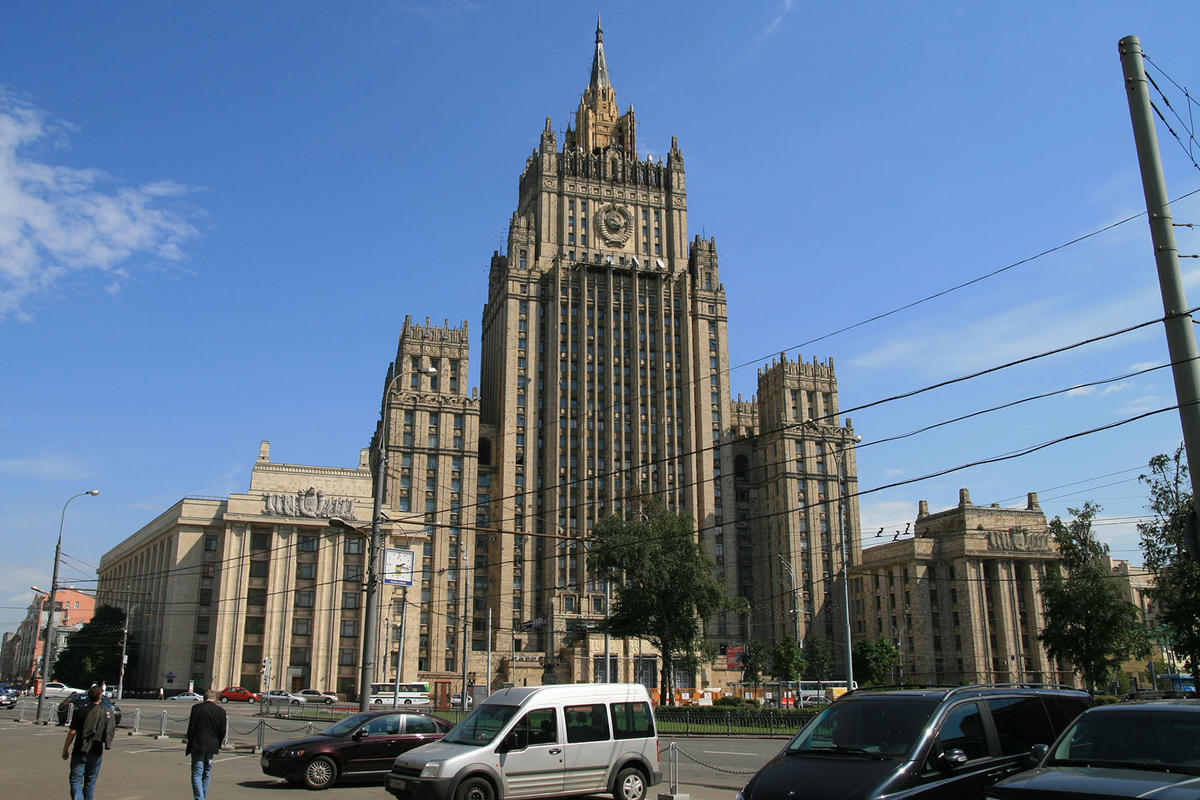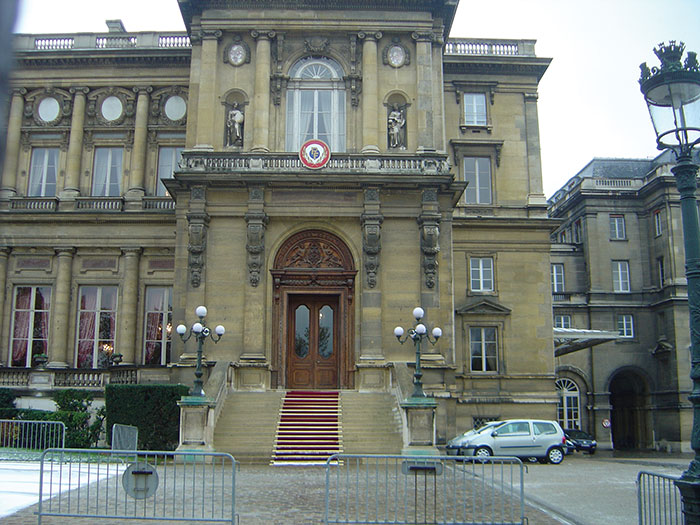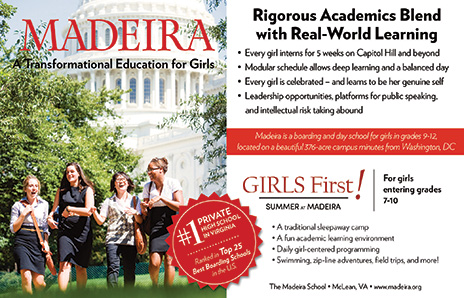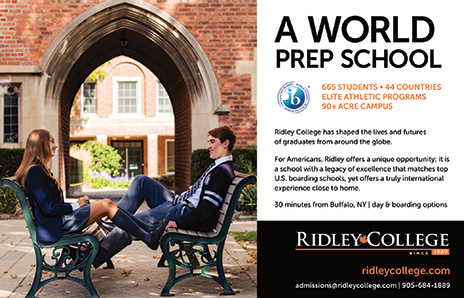The Making of an Effective Diplomat: A Global View
How do diplomatic services around the world ensure their governments have a steady supply of the most effective professional envoys?
BY ROBERT HUTCHINGS AND JEREMI SURI

Russia’s Ministry of Foreign Affairs, on Smolenskaya Square in Moscow.
Bernt Rostad [CC BY 2.0] via flickr (https://www.flickr.com/photos/brostad/277430545)
Educating Russia’s Future Diplomats
Russian diplomats are known for their strong professional training and deep linguistic and cultural knowledge of assigned regions.
The principal pipeline for new diplomats remains the Moscow State Institute of International Relations (MGIMO), which conducts rigorous training in diplomatic theory, area studies and foreign languages. Entry-level officers are expected to have mastery of at least two foreign languages, and they generally focus on one region of the world, moving from post to post while rising slowly through the ranks.
While the Service is still a prestigious and valued institution in Russia, it has faced challenges in recent years that have lowered its prestige, including competition from higher-paying private-sector jobs and complaints of limited autonomy and agency. Further, while in the past the vast majority of those attending MGIMO were specifically pursuing careers in the foreign ministry, this is no longer the case. A survey published in 2011 suggested that the ministry had failed to adapt to the needs of the post-Soviet generation.
—From “Developing Diplomats: Comparing Form and Culture Across Diplomatic Services,” Country Report: Russia, pp. 117-135.
Diplomatic services around the world face many similar challenges: nurturing officers who are globally aware and still deeply connected to their nation; managing the growing centralization of foreign policymaking in the offices of presidents, prime ministers and chancellors; engaging a growing array of non-state actors with whom they must do business; and widening their scope of expertise to include commerce, climate change, terrorism, energy and cybersecurity, among other issues.
With such challenges in mind, and thanks to funding and guidance from the American Foreign Service Association, the two of us led a project at the Lyndon B. Johnson School of Public Affairs during the 2016-2017 academic year aimed at examining the practices of diplomatic services in other major countries to see what lessons we might draw that would be helpful in improving the effectiveness of American diplomacy.
We worked with a team of 15 talented graduate student researchers on a comparative study of the development and operation of diplomatic services in eight countries: Brazil, China, France, Germany, the United Kingdom, India, Russia and Turkey. Our research focused on the recruitment, training, organization and promotion of diplomats in each country. It included a careful reading of published accounts of diplomatic training, interviews with diplomatic personnel in Washington, D.C., and discussions during a January meeting of the Austin Forum—an intensive three-day workshop for rising American, European and Latin American diplomats.
Assembled in country teams, the researchers asked a series of questions: What is your country’s diplomatic culture and professional ethos? How does an individual get chosen for the diplomatic corps in your society? What is the content and duration of initial training? What is your country’s budget for its diplomatic service in relation to other priorities? What are the expectations for early postings and career advancement? How are diplomats organized—by region or issue area? What are the opportunities and expectations for mid-career training? What is the trajectory for a typical diplomatic career? What role does your diplomatic service play in foreign policymaking, and how is this role changing?

Entrance of the Federal Foreign Office of Germany in Berlin.
Manfred Brückels (own work) [CC BY-SA 2.0 de], via Wikimedia Commons
German Diplomatic Culture
German diplomatic culture derives from the combined legacies of geography, history, tradition and philosophy. Although Germany did not achieve statehood and national unity until 1871, it has an extensive history and rich diplomatic tradition that long predates unification.
Its contemporary diplomatic style reflects the competing 19th-century traditions of Klemens von Metternich and Otto von Bismarck. The tradition of Austrian Foreign Minister Metternich was characterized by the maneuver and compromise needed to hold together the multiethnic Austro-Hungarian Empire, whereas the tradition of Prussian Chancellor Bismarck was that of machtpolitik (power politics) employed to unite Germany’s disparate principalities into a modern nation-state.
Trained as a diplomat himself, serving as ambassador to Russia and later to France, Bismarck created the modern diplomatic corps and left behind a tradition of urbane, well-prepared diplomats. The Auswärtiges Amt (foreign office) at Wilhelmstrasse 76 was a highly centralized and rigid operation, organized along military lines and tightly controlled by the chancellor, who once declared that “if an ambassador can obey, more is not required.”
—From “Developing Diplomats: Comparing Form and Culture Across Diplomatic Services,” Country Report: Germany, pp. 78-96.
The result was a series of case studies containing valuable insights about different diplomatic services. Of course the information was more accessible and detailed for those in democratic societies (e.g., the U.K., France and Germany). Information was harder to acquire for more closed countries (e.g., Russia and China).
The final report, completed in May, is available from the Lyndon B. Johnson School of Public Affairs and online. Though dealing with non-American countries, it identifies some “best practices” in the field of diplomacy that may contribute to reforming and improving our own distinguished U.S. Foreign Service.
We discuss some of the potentially valuable findings below, including presenting highlights on specific countries, following a brief review of the history of U.S. diplomacy.
The American Diplomatic Tradition
On Oct. 26, 1776, less than four months after signing the Declaration of Independence, Benjamin Franklin set sail from Philadelphia to France, where he became the first American diplomat. Franklin was a cosmopolitan inventor, businessman, politician and writer. He was also a skilled representative of his new nation, negotiating the first American alliance with France.
Franklin and his contemporaries understood that international diplomacy—the cultivation and management of relations with other states—was crucial for national survival and prosperity. He was part of a broader trans-Atlantic community of learned, wealthy gentlemen who used their personal skills to manage relations between rival governments in an era of aggressive empires. Diplomacy was not an alternative to war or peace, but instead an essential part of eliciting support from potential allies and, when necessary, balancing against potential foes in a complex international system.
For Franklin and his many successors foreign relations meant a mix of cooperation, competition and negotiations to maximize the emerging power of the United States and minimize its weaknesses. In a complex world with diverse actors, no country could go it alone. Diplomacy facilitated survival through interdependence and the pursuit of the national interest through direct communication, intelligence gathering and, when necessary, manipulation. The founders and successive generations concentrated their foreign policy activities on the work of diplomats, not the military, and the most talented American statesmen served their country in this capacity, following Franklin’s footsteps.

The official entrance of the Ministry of Foreign Affairs on the Quai d’Orsay in Paris, France.
Max12Max (own work) [CC BY-SA 4.0], via Wikimedia Commons
Fostering Strategic Thinking in the French Foreign Ministry
The French see themselves as missionaries for their revolutionary ideals of liberty, equality and fraternity.
French diplomats believe that they invented the modern art of diplomacy in the 16th century. They seek not only to secure the interests of the French state, but also to promote these ideals through public diplomacy and other forms of “soft power.” They do so in a relationship between posts and capital that seems to be unique: French diplomats are empowered to take stances that are consistent with the government policy without having to return to base at every juncture.
This flexibility has allowed diplomats to command conversations rather than react to the positions of others. Thus, France has gained success in the international community by consistently leading conversations and directing dialogue.
—From “Developing Diplomats: Comparing Form and Culture Across Diplomatic Services,” Country Report: France, pp. 59-77.
The 20th century was, in some ways, an era when this vision came to fruition. The United States and its counterparts on other continents expanded their diplomatic services, placing greater emphasis than ever before on sending some of their most talented and best-trained citizens abroad to negotiate treaties, manage daily relations and report on potential dangers. Embassies proliferated around the world, diplomatic conferences became more numerous and specialized, and organizations (especially the League of Nations and the United Nations) turned intensive diplomatic deliberations into a form of global governance. On the eve of World War II, the United States possessed a small, divided military (the Army and Navy were entirely separate) and would soon have a growing, highly educated and increasingly active Foreign Service. The diplomats largely determined American foreign policy in the mid-20th century.
The unprecedented expansion of America’s global presence, and its underlying internationalist goals (including democratization and free trade), required a more skilled, highly organized, professionalized diplomatic corps. Professionalization occurred across all areas of society during the 20th century (medicine, law, education, etc.), but it was especially pronounced in the field of diplomacy. The technically trained and carefully vetted representative of the state supplanted the aristocrat-turned-diplomat of old. Governments, including the United States, built large bureaucracies to train and organize the work of men (and eventually women) hired full-time to manage different elements of each nation’s foreign activities in trade, travel, military affairs, education and other matters. The new professional Foreign Service officers were selected on merit (usually through competitive examinations); they were highly trained (often with advanced degrees); and they were specialized (by field or region).
The professionalized diplomacy of the 20th century dominated the Cold War, and it continues to shape the post-Cold War world, although the traditional power of the Department of State has been diminished as the military has taken up more and more space in the foreign policy arena. American diplomats (George Kennan, Averell Harriman, Dean Acheson, Henry Kissinger, and many others) were at the center of U.S. policymaking, as were their Western European, Soviet, Chinese, Japanese and postcolonial counterparts. Since at least 1945, every major country has strived to hire, train and employ the most skilled professional diplomats for a variety of tasks, including: economic cooperation, counterterrorism, cultural exchange and conflict management.

The Ministry of Foreign Affairs of the People’s Republic of China, Beijing.
Max12Max (own work) [CC BY-SA 4.0], via Wikimedia Commons
Recruitment and Training in the Chinese Ministry of Foreign Affairs
Immediately after selection, new hires complete a six-month training course designed to familiarize them with the Ministry of Foreign Affairs and the Chinese diplomatic system. They then normally spend their first three-year assignment at MFA headquarters in Beijing and are not considered full diplomats until their first international posting.
As they progress through their careers, junior officers participate in a number of training courses—ranging from a few days or weeks to as long as two years—to be eligible for promotion. A unique feature of their professional development is that approximately 140 officers are sent to major national and international universities annually to complete a full year of graduate-level academic study.
Selection for this additional academic training is a strong indicator for future promotion to leadership ranks. Advancement to key leadership positions can occur at a relatively young age, and many ascend to ambassadorial posts by age 40.
—From “Developing Diplomats: Comparing Form and Culture Across Diplomatic Services,” Country Report: China, pp. 40-58.
Vive la Difference
One of the most striking things about the results of our survey of diplomatic services in eight key countries is how different their histories and cultures are, despite the many structural and procedural similarities among them. From these diverse examples, is it possible to identify the ideal diplomat? Surely not: skilled diplomats come in various shapes and sizes. Some are master strategists, others are gifted linguists with deep regional expertise, and still others are experienced administrators and leaders. Diplomatic services need officers with these varied talents: the attributes one seeks for the head of the planning staff are not the same as those sought for the director of a regional bureau or a United Nations ambassador. Vive la difference!
There are, nonetheless, certain practices these services share that ensure they will nurture and develop skilled and effective professional diplomats. All of them recruit highly qualified officers, many drawn from elite institutions like the École Nationale d’Administration (ENA) in France and the Moscow State Institute of International Relations (MGIMO) in Russia, which are specifically geared for the preparation of public servants. And all provide entry-level training designed to familiarize officers with the ministry as well as to acquire diplomatic skills.
The Brazilian, German and Indian services have the most extensive initial training of the eight countries studied, ranging from three semesters in Brazil to as long as three years in Germany. France, Russia and the United Kingdom do not provide the same level of initial training, relying instead on their rigorous selection process from elite institutions and the professional education entering officers received there before joining the service.
Several services offer focused training courses at various points throughout a career. Brazil and China link mandatory mid-career training courses to eligibility for promotion, while France requires mid-career management training after 15 years of service. The German and French services seem to be the most advanced in promoting a “work-life balance” through generous family leave policies, flextime work arrangements and job placement help for partners.
To regularize promotion procedures and make them more transparent, the British Foreign and Commonwealth Office has established Assessment and Development Centers, which administer a mix of written and interactive exercises focused mainly on management and leadership. Similarly, Turkey requires meritocratic examinations between the sixth and ninth years of service.
In all eight countries ambassadorial posts are almost entirely reserved for career diplomats. Most ambassadors to key posts have prior experience as ambassadors, speak the local language fluently and have served in senior levels in their home ministries. The contrast between the professional standards of these countries and the U.S. practice of assigning political appointees to key posts is conspicuous.

The North Block of the Indian Secretariat Building, which houses the Ministry of External Affairs.
Laurie Jones aka ljonesimages on Flickr [CC BY-SA 2.0], via Wikimedia Commons
Entry-Level Training in the Indian Foreign Service
India’s practice is unique among those diplomatic services we studied. New Indian diplomats are drawn from the highly selective Indian Civil Service examination process. Indian Foreign Service candidates are recruited alongside domestic counterparts such as the Indian Administrative Service, and their training begins with civil servants from across ministries and levels of government.
IFS officers subsequently undertake almost two additional years of training on top of the instruction they received as civil service recruits, including extensive rotations throughout the central government’s ministries, as well as military attachments.
Their training also includes innovative features meant to ensure that Indian diplomats are well-connected to their country at the grass roots level: for example, a 10-day trek in the Himalayas followed by a 12-day visit to a remote village and the Bharat Darshan (view of India), a tour of major cultural, commercial and historical sites. Brazil has an analogous but less extensive practice whereby officers spend time in various states to experience something of the diversity of their country.
—From “Developing Diplomats: Comparing Form and Culture Across Diplomatic Services,” Country Report: India, 97-116.
Lessons for the United States?
We did not include the U.S. Foreign Service in our multicountry survey deliberately, fearing that doing so might lead us to judge everything against the U.S. experience. We also hesitated to draw sweeping conclusions about which practices are most relevant or most deserving of emulation by the United States. A “best practice” in one country is not necessarily best for another.
There are many areas in which the U.S. Foreign Service excels. It recruits a highly talented group of entering officers, whose composition is more diverse than that of other services we studied. These rising diplomats acquire strong regional and language skills along the way, and they typically have a mix of postings that help them acquire a global perspective. Another strength of the U.S. system, often mentioned by foreign diplomats with admiration and envy, is the presence at the senior working level of many “irregulars” who come in from academia, think-tanks or law firms to take up staff positions at National Security Council, National Economic Council, policy planning staff and elsewhere. (Of course, this practice has the disadvantage of displacing FSOs who might have aspired to those same positions.)
Yet, compared to many of the services we studied, America’s diplomatic corps is disadvantaged at the entry level and again at the senior level. At entry level, officers are given a mere five weeks of orientation in the A-100 course, involving no serious substantive training. Then it may take several years before they have a chance to work in their career track, as all officers must do at least one year of consular work, and often more than that. As a result, many junior officers begin to lose some of the enthusiasm they had when they entered, especially since these early postings are followed by what can be a painfully slow rise through the ranks.
As U.S. diplomats progress through their careers, they often find that the Foreign Service does not offer sufficient time off to pursue advanced academic training or gain experience in another professional setting. Contrast this with their military counterparts, who routinely receive yearlong training at least twice in a career. The very few FSOs who are afforded mid-career academic opportunities most often receive their strategic training at the National War College, with the result that diplomats learn strategy from the military rather than the other way around.
The United States is an extreme outlier among foreign services in the number of political appointees who serve as ambassadors and senior leaders in the State Department. No other country permits this level of amateurism, and the United States pays a heavy price for being so disadvantaged at the top level of critical missions abroad and within the department itself.
None of this is to denigrate the U.S. Foreign Service, whose officers are often among the most skilled and dedicated of any diplomatic service. Rather, it is to suggest that there are lessons to be learned from other services that could better empower the U.S. Foreign Service to field the strongest officers at entry level, prepare them to be both experts and strategic thinkers, and ensure that only the most qualified individuals represent the United States at the highest levels.
These are the lessons that our nation’s leaders, in Congress and in the White House, must appreciate. And the American public must understand these insights, too. We need to nurture new Benjamin Franklins who will represent our country as skilled diplomats, and educate citizens about the importance of their work.















